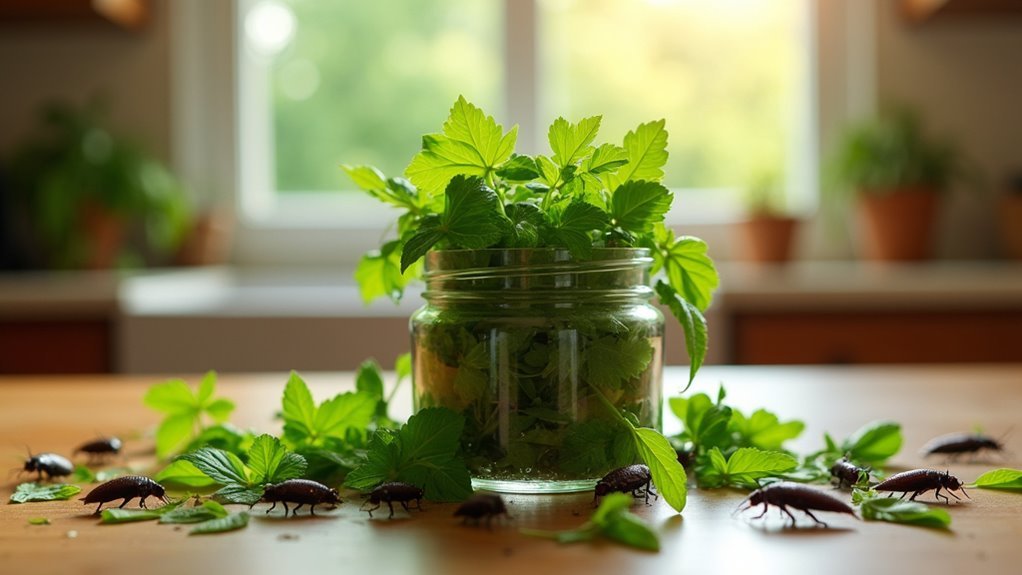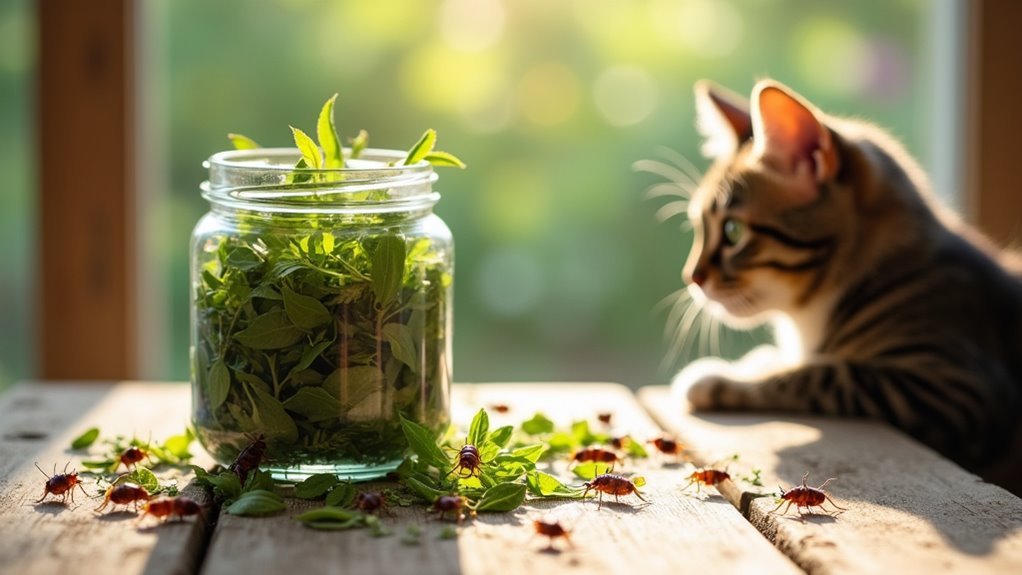You’ll create an effective cockroach deterrent by filling small cloth sachets with 1-2 tablespoons of dried catnip, which contains nepetalactone that disrupts roaches’ sensory receptors. Lightly mist the catnip with water to intensify its aroma, then place sachets in high-activity areas like behind appliances and under sinks. Replace every 2-3 weeks to maintain potency and monitor closely for best results. Strategic placement and proper maintenance will maximize this natural solution’s effectiveness.
Why Catnip Works Against Cockroaches

While synthetic pesticides dominate the market, catnip’s natural compound nepetalactone delivers surprisingly powerful results against cockroaches.
You’ll find this active ingredient disrupts roaches’ sensory receptors through its strong odor, creating an effective deterrent that outperforms many commercial insecticides.
When you use catnip strategically, it masks the food odors that typically draw cockroaches into your home.
This scent-masking effect reduces their motivation to enter treated areas entirely. You’re fundamentally creating an invisible barrier that these pests instinctively avoid.
The effectiveness comes from cockroaches’ heightened sensitivity to nepetalactone.
Their survival instincts recognize this compound as threatening, triggering avoidance behaviors.
You’ll notice fewer roaches in areas where you’ve applied catnip, making it a reliable natural alternative to harsh chemical treatments.
Materials and Ingredients You’ll Need
Since you’re working with natural ingredients, gathering the right materials guarantees your catnip trap delivers maximum effectiveness against cockroaches. You’ll need dried catnip as your primary weapon—approximately 1-2 tablespoons creates the perfect aromatic deterrent. Create containment using breathable fabric like muslin or repurpose an old sock as your trap vessel.
| Material | Purpose |
|---|---|
| Dried catnip (1-2 tbsp) | Primary roach deterrent |
| Muslin/old sock | Breathable container |
| Water/spray bottle | Moisture enhancement |
A spray bottle with water enhances catnip’s potency—lightly misting the dried herb intensifies its scent. Once you’ve assembled these simple materials, you’re ready to deploy strategic traps in roach-prone areas like under sinks, behind appliances, and dark corners where these unwanted guests typically gather.
Step-by-Step Catnip Trap Preparation

Three simple steps transform your gathered materials into an effective cockroach deterrent. You’ll create powerful sachets that release catnip’s natural repelling properties exactly where roaches frequent most.
Start by filling small cloth bags or sachets with dried catnip, ensuring you don’t overpack them. The herb needs space to release its aroma effectively.
Next, make sure you position these sachets in areas where you’ve spotted roach activity – behind appliances, under sinks, or along baseboards work best.
Key preparation steps:
- Fill sachets loosely with dried catnip for ideal scent release
- Combine catnip with bay leaves or garlic for enhanced potency
- Place sachets strategically in high-activity roach zones
- Mark replacement dates to maintain effectiveness every few weeks
Monitor placement areas regularly and adjust positions based on ongoing roach activity patterns.
Strategic Placement and Application Tips
Proper placement doubles your catnip trap’s effectiveness against cockroaches. Focus on dark, hidden areas where roaches typically hide – behind appliances, inside kitchen cabinets, and under sinks. This strategic placement maximizes your catnip’s repellent properties.
Replace sachets every few weeks to maintain potency and guarantee continuous deterrence. Monitor these areas closely; if roach activity increases, relocate sachets to more effective spots.
Enhance your approach by combining catnip with other natural repellents like bay leaves or lemon juice. This creates a multi-faceted defense system against infestations.
Use catnip alongside baited sticky traps for best results. While catnip repels roaches from food sources, traps capture any remaining pests. This dual strategy greatly improves your overall pest management effectiveness.
Maintenance and Effectiveness Monitoring

Monitor your trap’s location and adjust positioning if roaches shift their hiding spots based on food sources and environmental changes.
Clean the surrounding area frequently to eliminate debris that might divert roaches from your trap.
Key monitoring practices include:
- Replace catnip sachets every 2-3 weeks to maintain potency
- Log trap activity and roach counts for effectiveness assessment
- Adjust trap placement based on changing roach behavior patterns
- Combine with other pest control methods if results remain minimal
Frequently Asked Questions
How to Use Catnip to Deter Roaches?
You’ll place dried catnip in small sachets around areas where you’ve spotted roaches. Replace it regularly since effectiveness fades over time. You can mix it with garlic powder for enhanced deterrent power.
What Is the Most Effective Homemade Cockroach Killer?
You’ll find the soap and borax mixture most effective for killing cockroaches homemade-style. It suffocates them on contact while disrupting their digestive systems, making it deadlier than baking soda combinations or repellent sprays.
What Is the Strongest Thing to Kill Cockroaches?
You’ll find fipronil-based insecticides are the strongest cockroach killers available. These commercial products disrupt their nervous systems most effectively. For natural alternatives, you can use boric acid, which acts as a powerful stomach poison when roaches ingest it.
What Smell Do Roaches Hate the Most?
You’ll find roaches hate catnip’s nepetalactone compound most intensely. They can’t stand peppermint, eucalyptus, bay leaves, garlic, and cayenne pepper either. Lemon juice’s citrus scent also repels them effectively through strong aromatic deterrence.
In Summary
You’ve now got a powerful, natural weapon against cockroaches that won’t harm your family or pets. Remember to refresh your catnip traps every two weeks for maximum effectiveness. Keep monitoring the areas where you’ve placed them, and don’t hesitate to adjust locations if you’re not seeing results. With patience and proper placement, you’ll notice a significant reduction in roach activity within days.





Leave a Reply